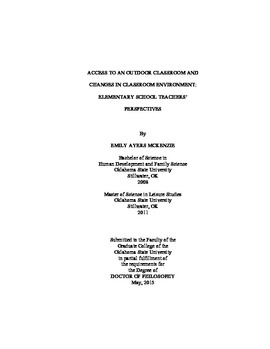| dc.description.abstract | The current climate of education is focused on student outcomes. Outdoor and Environmental Education have been shown to positively impact academic achievement, classroom environment and culture, as well as increased engagement and motivation (Desmond, Grieshop & Subramaniam, 2002; Lieberman & Hoody, 1998; Volk & Cheak, 2003). The purpose of this study is to investigate the relationship between access to an outdoor classroom and changes in classroom environment. Teachers from two elementary schools in a moderately small community in Oklahoma completed the Teacher Version of the My Class Inventory - Short Form (Sink & Spencer, 2007) once in the September and again in February. Teachers at the treatment school had access to an outdoor classroom and teachers at the comparison school did not. Due to demographic differences between the two schools, first, pre-test differences were analyzed using a Mann Whitney U. There were no statistically significant differences in pre-test scores on the scales of competitiveness, difficulty, or peer relations between the treatment and comparison schools. There was a statistically significant difference in pre-test scores of satisfaction; however, this statistical difference was no longer present among the post-test scores. Based on the literature that shows outdoor education can be related to positive changes in classroom environment and student academic achievement, this change in satisfaction scores could be attributed to access to an outdoor classroom (Desmond, Grieshop & Subramaniam, 2002; Glenn, 2000; Lieberman & Hoody, 1998; Volk & Cheak, 2003). There were no statistically significant differences in post-test scores on competitiveness, difficulty, or peer relations. However, descriptive data illustrates a larger picture of the use and benefits of the outdoor classroom at the treatment school, further supporting previous literature about the impact of outdoor education and environmental education. This study paves the way for future research on the relationship between outdoor education and the indoor classroom environment. | |
